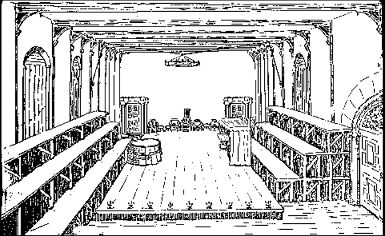The first Blackfriars Theatre
This reconstruction shows an empty stage set for Lyly's play Campaspe. There are benches for the spectators, doors for the actors at the rear, two "houses" to locate the action, one Diogenes' tub, one Apelles' studio. The stage is lit with candles.
In 1576 part of the building was rented to Richard Farrant, Master of the Chapel Children, thus becoming the first Blackfriars theatre. The plays of John Lyly were performed there.
The theatre held special status, standing within the City's walls, but not under its jurisdiction. The first Blackfriars was closed in 1584 because the plays presented were considered too outspoken politically.
More About the Blackfriars. . .*
Footnotes
-
The Blackfriars
The Blackfriars was originally a Dominican convent, established in 1275. It was deconsecrated when Henry VIII dissolved the monasteries, and thereafter served a number of public functions, as a depository for records, a house of parliament, and a meeting place for the Privy Council. In 1529 it was the site of a trial for the annulment of the marriage between Henry VIII and Catherine of Aragon. The large building was subdivided, parts of it being used as residences.
When it was established as a monastery, the Dominicans had obtained permission to divert the City walls in order to change the boundary of their precinct. The entire Blackfriar's precinct remained outside City jurisdiction until 1608.
The importance of this distinction was that the actors could evade the City's ordinances against them, while performing in a convenient location within the city walls.
